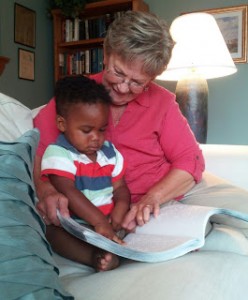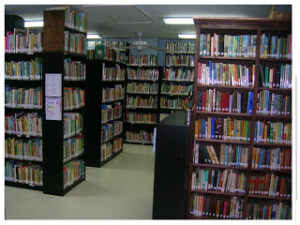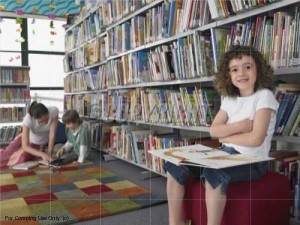On Monday, we posted a list of book and library resources from Christian librarians Betsy and Megan at . Today, however, I’d like you to meet a mother (Liz) and daughter (Emily Cottrill) combo who have started a new kind of library with a unique objective. They are gathering up books from the “golden years” of children’s publishing–which they see as 1930-1960–and opening them up to children of all walks of life in Appalachia. Their website, www.livingbooklibrary.com, is a testament to that work, and through it they have helped other homeschoolers start their own community libraries. I’ve invited them to share their inspiring story here today.
 1. You have a library that is open to the public, but stands in stark contrast to our “public” libraries. Can you tell me a little about your library and how it got started?
1. You have a library that is open to the public, but stands in stark contrast to our “public” libraries. Can you tell me a little about your library and how it got started?
Liz: When we lived in Michigan, our family belonged to a private homeschool library that a family in our community had made available in their home. The first time we visited this family’s library I knew it was going to make my homeschooling a joy and it did. The books in their collection were mostly out-of-print books from the “golden age of children’s literature” (1930-1960’s). They were organized by the Dewey Decimal System and Michelle, the homeschool librarian mother was a wealth of information about books and which ones would be most useful to us. Then we moved away and I was at a loss as to how to homeschool my children without that marvelous library.
Things Michelle had tried to convey to me about the changes in children’s literature suddenly I now had to deal with; for example, she herself had discovered as she searched for books of outstanding literary quality for her own children were no longer in the public library. As she obtained her library science degree and worked in the field, she realized that her life-long notion that libraries were collections of all that is best in literature was mistaken–they were instead repositories of all that is popular and current. Unfortunately, quality literature has been on a downward spiral for decades. It is increasingly difficult to find excellent material for children to read and even classics are generally out of favor.
As I experienced this reality myself, I became an avid book collector of the rare and difficult to find treasures of a former day when children were considered worthy of the finest writing and capable of understanding great ideas. Even on a small budget, I was able to dig out some of these, and then in addition, we began stumbling upon various gold mines of books – elementary schools closing and dumping their library contents, anonymous gifts of boxes full of beautiful old books.
 Because we had been involved in a private homeschool library, my family began talking about running one ourselves. I was full of objections, not the least of which was that I was still homeschooling my three youngest. And, quite honestly, I was – terrified might not be an exaggeration – to loan my precious old, difficult-to-replace books, to others to use in their homes. Who knew what tragedies might befall them. I, of course, was uncomfortable with this struggle and finally had to face the Lord’s command to “love your neighbor as yourself.” It’s hard to sit on a storehouse of riches when your neighbors are hungry.
Because we had been involved in a private homeschool library, my family began talking about running one ourselves. I was full of objections, not the least of which was that I was still homeschooling my three youngest. And, quite honestly, I was – terrified might not be an exaggeration – to loan my precious old, difficult-to-replace books, to others to use in their homes. Who knew what tragedies might befall them. I, of course, was uncomfortable with this struggle and finally had to face the Lord’s command to “love your neighbor as yourself.” It’s hard to sit on a storehouse of riches when your neighbors are hungry.
We put out the word on local homeschool email lists that we were offering memberships in our family’s library. Local families filled out an application and paid a small fee to belong to our library for a year as well as signing an agreement to be responsible for treating the books well. Twelve families took the plunge and had such a great experience that it wasn’t long before we had a waiting list. Our home was open two afternoons a week for families to come and check out books. It was a very exciting time as we formed relationships with these families, learned the parents’ concerns for their children’s needs, had conversations with children who were exploring literature, and that has always been the greatest reward for all the work that is involved. A public library is something folks feel entitled to use as they wish; ours was a place for relationships and making friends with books as well as the people who read them. We began with 3,000 volumes and now offer about 15,000. Most of the acquisitions have been purchased with particular individuals in mind.
2. Charlotte Mason’s idea of living books seems pretty central in your thinking. Can you explain what a “living book” is?
liz: First, let me say that defining a living book is about as challenging as trying to define life. There, however, is the similarity. Living books come alive to you when you read them because they are full of living ideas. I sometimes say, they get inside of you and you get inside of them. The truth is, living books are full of living ideas that capture your imagination; you can’t stop thinking about what you have read in them; the thoughts and ideas of an author who wrote from his or her own life experience and knowledge are taken into your own mind and your thoughts and knowledge and experience change as a result. Usually, good books are written by not only gifted writers who know how to express themselves in the best language, but are also experts in their field, passionate about their subject, or are just plain great storytellers.
I believe we were made in the image of God, the greatest Storyteller, and story is how He has chosen to communicate with us from the beginning. The Bible is His story. Jesus himself is the Word. We were made to learn through and use language. Words bring life. The one true Living Book is the Bible, which is sharper than any “two-edged sword” and is literally life changing when read, considered, and applied. Jesus himself used parables–truth revealing stories using every day life–to communicate truth, taught nothing without them.
 Charlotte Mason believed these things. She worked with children for more than sixty years and was such an astute observer of them. It became quite apparent to her that children instinctively learned knowledge through story. The quickest way to the growth of the mind was in touching their heart through a narrative in which information was effortlessly acquired. Since children are whole persons, not containers needing filling or slates to be written on, they deserve the respect of not being fed predigested crumbs of information in artificially predetermined increments deemed fit for them.
Charlotte Mason believed these things. She worked with children for more than sixty years and was such an astute observer of them. It became quite apparent to her that children instinctively learned knowledge through story. The quickest way to the growth of the mind was in touching their heart through a narrative in which information was effortlessly acquired. Since children are whole persons, not containers needing filling or slates to be written on, they deserve the respect of not being fed predigested crumbs of information in artificially predetermined increments deemed fit for them.
Often we explain living books by simply showing the difference. We take a typical biography found on our local public library’s shelf, say about Geronimo. We read it, very informational and usually dry as dust, for a page, then pick up a copy of, say, Jim Kjelgaard’s “The Story of Geronimo,” and read one page. The audience is usually begging us to turn the page and read further. They have to know if he really stole that beautiful horse – and they get it.
3. You recently hosted a Homeschool Librarians’ Conference. Who attended and what did you hope to accomplish through that conference?
Emily C.: On June 25 people from 10 different states traveled to our remote corner of the world to learn about opening a library full of living books to share with their own communities. One was a single mom from inner-city LA hoping to share nourishing truth with the children of her neighborhood, a few were homeschooling families whose children had left home, but whose collection of books used in their schooling remained. Many were women whose passion for collecting and preserving the best literature available had been sparked by their own adventures in the pages of nearly-forgotten books.
 Our goal was to equip these families to preserve their collections, offer practical advice, and ultimately expand their vision for the great need for truth-steeped, honorable, life-changing books in the hands of children. We are blessed to see the first fruits of our labor as two libraries have opened this fall, and several more are planning to soon–even sooner than their librarians had intended before attending the conference!
Our goal was to equip these families to preserve their collections, offer practical advice, and ultimately expand their vision for the great need for truth-steeped, honorable, life-changing books in the hands of children. We are blessed to see the first fruits of our labor as two libraries have opened this fall, and several more are planning to soon–even sooner than their librarians had intended before attending the conference!
4. What impact have you seen your library have on families in your community? What about other similar libraries?
Liz: I just had a mother in my library on Monday that told me she couldn’t teach her children without the use of our library. She has eight children and checks out probably 75 books a month.
We have received this kind of feedback from the beginning. Once moms observe how much their children can soak up from well-written books on astronomy, Rembrandt, the Middle Ages, they find their job easier. We have helped moms whose children were struggling to read, hating to read, disinterested in anything to do with school. I have gotten phone calls from them, ecstatic to find a son devouring a book. For many children, it is our joy to broaden the variety of genres of literature they find appealing. Once last winter we realized that our entire shelf of Shakespeare plays was empty.
There are families from every walk of life and social strata who have participated in our library. We average about 50 families a year. There are even some families who have rarely ventured out of our little Appalachian region, but have gone all over the world in books though, and met some of the most fascinating people in history here. It is not just their children, but many parents have become more involved in literature as well. I really get excited when dads confess to sneaking our books on airplanes for business trips, or staying up after their children went to bed to finish a story, or confess to learning how to read aloud to their children.
When we opened our library I knew of two other similar ministries in the country, both in Michigan. We have a yahoo group for people learning about how to operate a homeschool library that now has 150 members. There are about 35 such family-run endeavors getting underway or already operating now. (Liz)
5. If someone were interested in supporting your endeavor, or if they wanted to start a library in their community, what would you recommend to them?
We have been so blessed by countless people who have supported our library in so many ways. The most helpful thing people can do to support our ministry is to pray for us–pray that we will be used in our community, that the vision for these libraries will spread far and wide, and, most importantly, that the lives of children will be impacted for the Kingdom. Another way we see support is through people sharing our website with others. We sell duplicate copies of excellent books we already have in our library in order to fund our endeavor. If we can help others build their libraries and support ours at the same time we are doubly blessed! We long for a cultural reformation–for the hearts and minds of the coming generations to return to the faith of their fathers and we believe that quality literature plays an integral role in that reformation. The blog posts, book lists, and information that we post on our website is written in order to educate and encourage people in this mission.
If someone is interested in learning more about sharing their collection, we welcome them to join the discussion on our Yahoo Group: HomeschoolLibrary. Membership can be gained by sending an email to homeschoollibrary-subscribe@yahoogroups.com. We are also in the process of producing some materials to assist future librarians set-up, operate, and promote their libraries. Information about these materials will be posted at www.livingbookslibrary.com as they become available.
Thanks so much to Liz and Emily for taking the time to share this vision with us. I wonder if you guys have any questions for them. Do you have living books in your home or school library? If there were a library like this in your area, would you consider supporting it?
Support our writers and help keep Redeemed Reader ad-free by joining the Redeemed Reader Fellowship.
Stay Up to Date!
Get the information you need to make wise choices about books for your children and teens.
Our weekly newsletter includes our latest reviews, related links from around the web, a featured book list, book trivia, and more. We never sell your information. You may unsubscribe at any time.
We'd love to hear from you!
Our comments are now limited to our members (both Silver and Golden Key). Members, you just need to log in with your normal log-in credentials!
Not a member yet? You can join the Silver Key ($2.99/month) for a free 2-week trial. Cancel at any time. Find out more about membership here.
5 Comments
Leave a Comment
You must be logged in to post a comment.


I have wanted to start a library like this one for several years, but I haven’t figured out where to find the space. My house is overflowing with books, many of them classic, hard-to-find books that I would love to loan out to willing readers, but I don’t have a space where families could come and browse.
You could pray with me that if this sort of library is God’s will, I would find a place to do it.
[…] Living Libraries – What an amazing idea. I see a tremendous “community building” element to this that makes it challenging to me personally. […]
Sherry, So happy to pray for you about this. And glad you’re inspired by Liz’s and Emily’s story! They are truly pioneers.
Sherry,
We sympathize with the concern about space because every collector has this pressing issue. On the other hand, for almost two years our family of six (4 adults) lived in 900 sq. ft. with 8,000 books and had 50 families trooping in to share them. Where there’s a will, there’s a way as it goes, but perhaps you will find some helpful ideas in an article we wrote called “A Space for Books.” (https://www.livingbookslibrary.com/2012/08/living-with-living-books-part-3-place.html)
Liz and Emily
Very inspiring! I’d love to do soemthing like this. A dream to pray about….